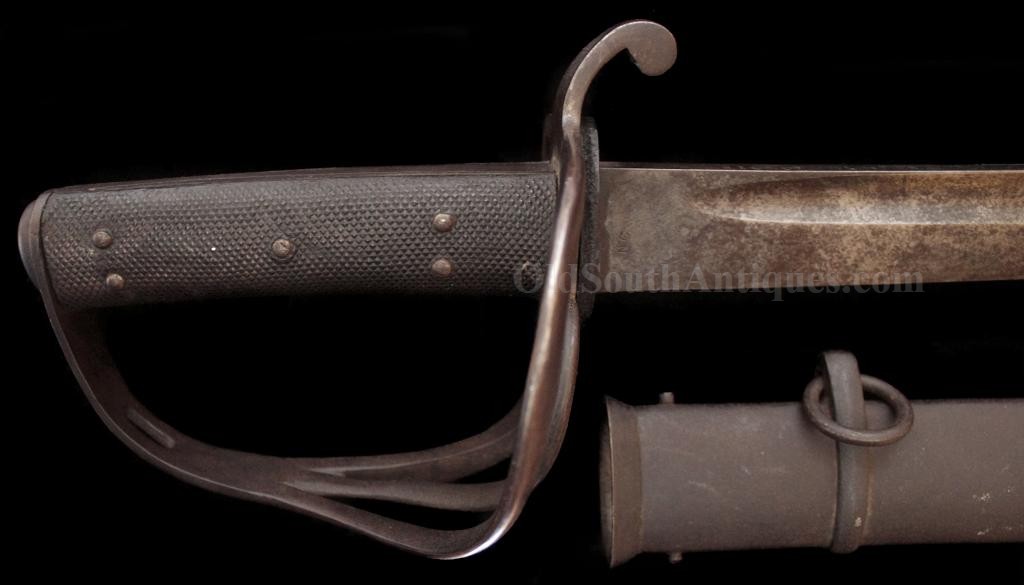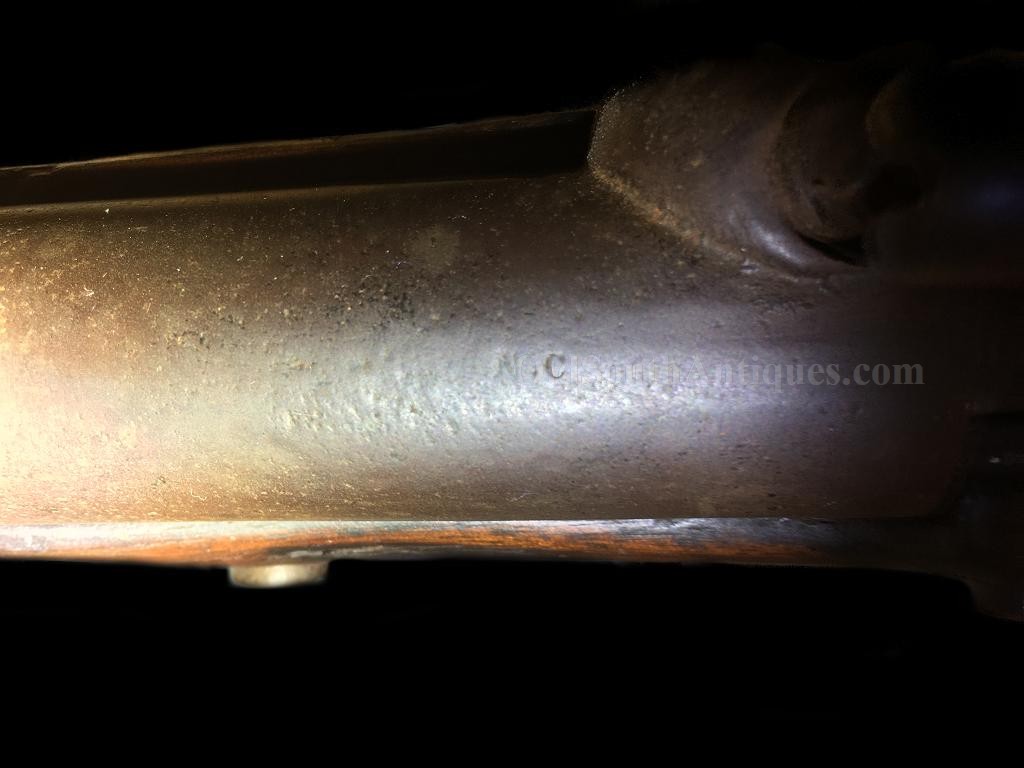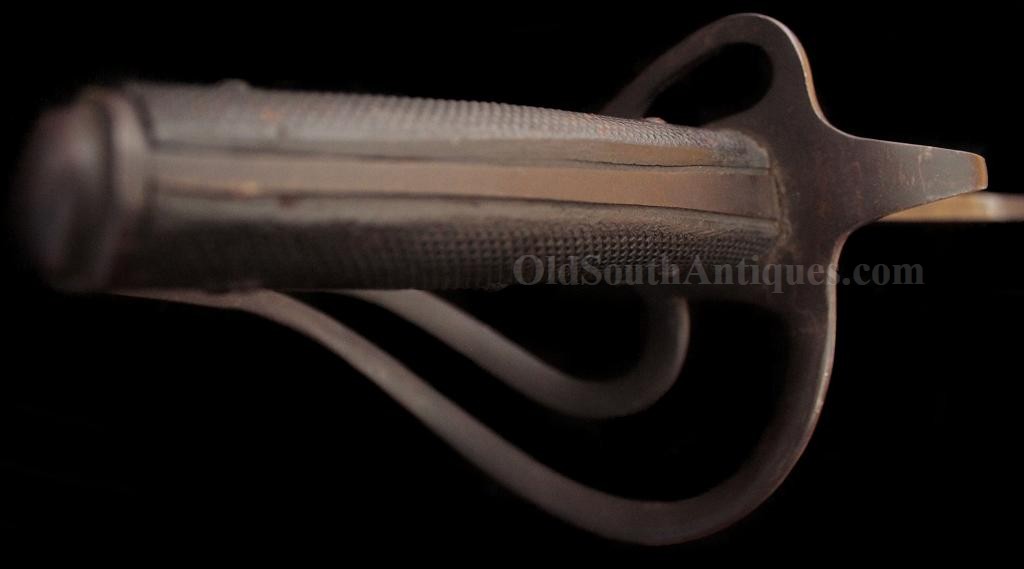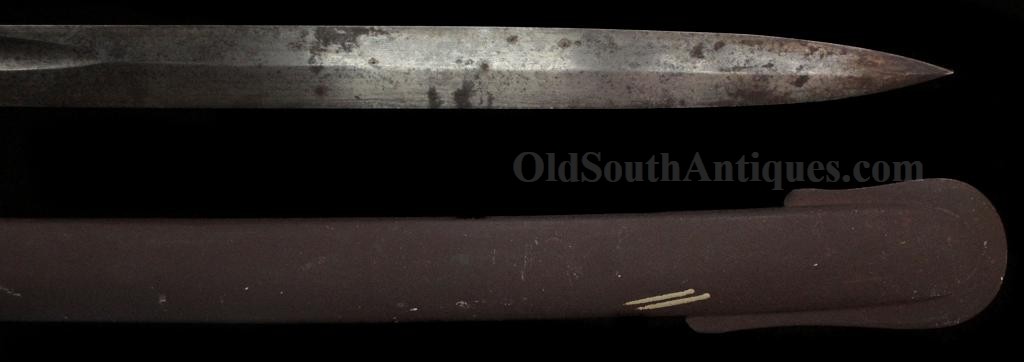
| Catalog | Past Items | Order Info | Terms/Conditions | About Us | Inventory Clearance |
Tens of thousands of Pattern 1853 (P53) Cavalry swords were purchased by the Confederate government during the War Between the States.
Purchased in England by Confederate allied agents, the swords were shipped to the neutral ports of Bermuda, Havana or Nassau. Here they were reloaded into swift moving blockade-running ships, which under cover of darkness slipped into Confederate controlled ports.
Like the Enfield rifles imported by the Confederacy, most were unmarked and cannot be positively identified as Confederate used. There are only a few ways to identify the Confederate imports. Though only having a MOLE marking, the P53 sword with a brass guard can be identified as Confederate because the British only used iron for their own troops, and its similarity to the Courtney and Tennent marked cutlass’s brass guards. Consequently, a P53 with an iron guard can only be considered Confederate if marked SIC & Co. (S. Isaac Campbell & Co.) or ISAAC & Co. by Southern importer Isaac & Co, or if it has impeccable, documented, Confederate attribution.
The sword shown here is one of those positively identified as a Confederate purchase. The sword’s spine is stamped with the early SIC & Co. London marking. While the later ISAAC & Co. stampings were done with a unitary die and are all alike, these early SIC & Co. were stamped with individual dies and each is slightly different. Deterioration of the dies can be noted throughout the production prior to this method being replaced by the ISAAC & Co. unitary die. Note that the same defects exhibited in these dies, are identical to the dies used in the example shown in The English Connection.
The P53 swords were imported by individual states, and the Confederate Government. In fact, the Official Records states that Caleb Huse shipped 16,178 cavalry swords in the first two years of the War. While records are slim, we know from a surviving March 10, 1862, invoice that 1400 cavalry swords, shipped on the Minnafrom S. Isaac & Company, used the "SIC & Co” mark.[i] These arrived in 28 cases of 50 swords. The swords had been purchased for $8.37 each.
These swords were shipped by SIC & Co. to his partner, G. Campbell in Bermuda.[ii] Campbell housed them in the warehouses that he rented in St. Georges, Bermuda[iii]after an inspection by himself, Ordinance Agent Major Norman S. Walker and Major Smith Stansbury of North Carolina. Campbell engaged blockade runners to take the cargoes to Wilmington, NC. Once in Wilmington, Campbell loaded and brought back cargoes of cotton.[iv]
Collectors have long known of the Enfield rifle-muskets imported and marked by Louisiana, South Carolina, Georgia and North Carolina. Other states also procured arms, but no other state marked specimens are known. The vast majority of these imports were unmarked by the purchaser. North Carolina agent Colonel John L. Peyton traveled to Liverpool in October of 1861 to meet with Caleb Huse and Maj. Ed. C. Anderson to purchase arms. A surviving letter from Peyton to North Carolina Governor H. T. Clark advised him that he had ordered the Enfield rifles he purchased, (to be) stamped with the letters NC. These arrived on the Nashville, April 24, 1862. Of these, there are only four known survivors. State marked examples of any state are exceedingly rare.
Likewise, though we know that the Confederate Government and various Southern States purchased thousands of P53 swords, only a few are marked. Up until the discovery of the NC marked, SIC & Co. P53 shown here, only Georgia and South Carolina marked examples had been known to exist. Only a very few of the Georgia marked swords and only one S.C. marked example, and this is the only known NC marked P53. The small NC on the sword is also found on some pre-war muskets. I have included a picture of one here for comparison; you can easily see the same odd offset of the N’s legs on the musket stamping and the use of individual dies.
The sword is in excellent condition. The iron hilt and pressed leather grips are perfect. The throat washer is a replacement. The blade is perfect but for one tiny nick. The markings are crisp and clear. The scabbard is perfect, without a single dent. In other words, there are few of the Confederate imported and used swords that remain in such fine condition, and the North Carolina and S. Isaac & Company markings carry it into that stratosphere of "the very best”.
[i] McRae Papers, Disk 3, H-003 See Pic page 296 English Connection
[ii] The first initial is at this time speculative, but G. Campbell was a Confederate agent and bond holder in Bermuda. See English Connection page 26. See also: Confederate blockade running through Bermuda, 1861-1865: letters and cargo manifests. Pages: 46, 59, 72, 93.
[iii] "As a consequence of the naval blockade, Bermuda — along with the Bahamas and Cuba — became a center of Confederate commerce. A steady stream of fast-running ships from the South clandestinely skirted the Union blockade, passing through St. George’s carrying cotton from Charleston, South Carolina and Wilmington, North Carolina for English manufacturers; they made the return journeys freighted with European armaments. Bermuda was both a transshipment point where cotton was directly exchanged for British weapons warehoused here and a refueling depot for Confederate blockade runners making transatlantic runs.”
[iv] Confederate blockade running through Bermuda, 1861-1865: letters and cargo manifests. Pages: 46, 59, 72, 93.
Copyright © 2025 OldSouthAntiques.com All Rights Reserved.
Privacy Policy | Terms of Use
Powered by Web-Cat Copyright © 1996-2025 GrayCat Systems







